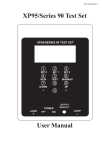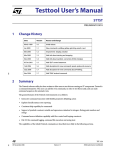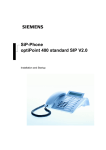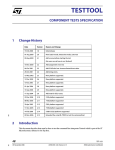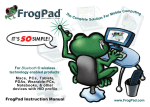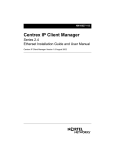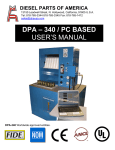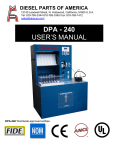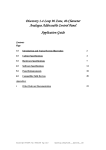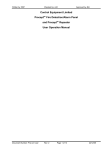Download XP95/Series 90 Test Set User Manual
Transcript
XP95/Series 90 Test Set User Manual Contents Page 1.0 General Description 2 2.0 User Functions 2 3.0 Operating Instructions 3 Appendices i ii Technical Specifications Other Relevant Documentation Document Ref: testtool.doc/Rev0 03.03.99 Page 1 of 14 Originator MC Checked by PM Approved by JBJ 14 15 1.0 General Description The Apollo XP95/Series 90 test set is a self-contained, hand-held test unit capable of providing a number of useful functions in relation to individual monitors, ancillary devices or complete circuits of analogue addressable devices in the Apollo XP95 or Series 90 ranges. The main function of the XP95 test set is to enable an engineer to test and commission a loop of devices fully before the control panel is installed. It can also be used for on/off-site maintenance and device performance testing and includes a powerful data log function for long-term soak testing. The unit may be powered from an AC power supply unit or from its own internal batteries. When the test set is used on the mains supply, the batteries are continuously maintained in a healthy condition by the integral charger circuit. The length of time for which the test set may be run on batteries varies greatly, depending on the loop load and printer usage, but approximately 8 hours can be assumed as an average. Sockets on the membrane allow the engineer to connect the loop or device to the test set (note that correct polarity must be observed when isolators are fitted). A printer is available as an optional extra. For ease of transport the test set is supplied with a carrying case, complete with charger and leads. 2.0 User Functions The user functions are displayed in the form of a menu with option numbers and are selected by pressing the appropriate number on the keypad. Available functions are: 2.1 Function 1 - Single Address Test This function allows the user to interrogate and control individual devices. The test set provides a display which shows the device type, returned address and analogue value, as well as the input and output bit status. The user can set the output (or forward command) bits to logic high or logic low. 2.2 Function 2 - Device Types Selecting this function causes the display to show single letter characters which identify the type of device at each of the first 63 addresses. The second page of information – for devices 64 to 126 – is accessed by pressing the # key. 2.3 Function 3 - Loop Scan Test When this function is selected, the test set prompts the user to enter an analogue value as a reference. The unit automatically scans all addresses and provides a list of all devices which report analogue values equal to or greater than the level selected. 2.4 Function 4 - Identify Device When 4 is selected, the test set automatically polls all addresses, starting at 1, until it encounters a device. It then displays the address, type, analogue value and series type of the device found. Document Ref: testtool.doc/Rev0 03.03.99 Page 2 of 14Originator MC Checked by PM 2.5 Function 5 - Interrupt/Alarm Test With this function selected, the test set reports interrupt bits placed on the line by manual call points or alarm flags placed by XP95 monitors. XP95 interrupt or alarm addresses are also shown. 2.6 Function 6 - Print Device Types This function is identical to function 2, with the exception that device types are printed rather than displayed on the LCD. (The printer is an optional extra). 2.7 Function 7 - Print Loop Report This allows the engineer to obtain a print-out of the address, analogue value, device type, device series and input/output bit status of a single device, a group of devices or all devices connected to the loop under test. 2.8 Function 8 - Loop Data Save This function allows the engineer to save up to four loops of device data so that a review can be carried out at a later stage. 2.9 Function 9 – Loop Data Log By selecting this function the performance of a device or loop of devices can be logged over a period of time and the results examined or printed at a later stage. 2.10 Function 0 – Help Menu A full description of the functions of the various keys is available by selecting this option. 3.0 Operating Instructions When the test set is first powered up it will display and print (if a printer is connected) a message as follows: APOLLO FIRE DET XP95/S90 TEST SET A1450 SOFTWARE V6.0 1/11/93 After the initialising message, the test set will show the first of three menu options: 1: SINGLE ADDR. TEST 2: DEVICE TYPES 3: LOOP SCAN TEST * = NEXT PAGE By selecting *, the next three options are displayed: 4: IDENTIFY DEVICE 5: INT/ALARM TEST 6: PRINT DEV. TYPES * = NEXT PAGE The third menu option: Document Ref: testtool.doc/Rev0 03.03.99 Page 3 of 14Originator MC Checked by PM 7: PRINT LOOP REPORT 8: LOOP DATA SAVE 9: LOOP DATA LOG * = NEXT PAGE Finally, the Help option is shown: 0: HELP MENU * = NEXT PAGE In the following pages the individual menu operations are described and instructions for use of the options given. Each option is referred to as it appears in the test set display. 3.1 1. Single Addr. Test This option allows an engineer to monitor a single device. The information shown is: • • • • • • the address the analogue value the device type device series (XP95 or Series 90) output bit status input bit status The display format is: ADDR VALUE TYPE OPT * = EXIT In this mode, keys under test. 3.1.1 1 24.5 to XP95 BITS 012 O/P 000 I/P 000 can also be selected in order to carry out further tests on the device Key When key is pressed, output bit 0 changes from logic 0 to 1. DEV VALUE TYPE OPT * = EXIT Press key 1 24.5 XP95 BITS 012 O/P 000 I/P 000 and the display changes to: DEV VALUE TYPE OPT * = EXIT Document Ref: testtool.doc/Rev0 1 24.5 03.03.99 XP95 BITS 012 O/P 000 I/P 000 Page 4 of 14Originator MC Checked by PM 3.1.2 Key When key is pressed, output bit 1 changes from logic 0 to 1. DEV VALUE TYPE OPT * = EXIT Press key BITS 012 O/P 000 I/P 000 1 24.5 XP95 BITS 012 O/P 000 I/P 000 Key When key is pressed, output bit 2 changes from logic 0 to 1. DEV VALUE TYPE OPT * = EXIT Press key 1 24.5 XP95 BITS 012 O/P 000 I/P 000 and the display changes to: DEV VALUE TYPE OPT * = EXIT 3.1.4 XP95 and the display changes to: DEV VALUE TYPE OPT * = EXIT 3.1.3 1 24.5 1 24.5 XP95 BITS 012 O/P 000 I/P 000 Key This key enables the selection of a new device address: CURRENT ADDRESS = 1 NEW ADDRESS? * = REDO # = OK To select a new address, press the appropriate numeric keys and enter with the # key. 3.1.5 Key This key initiates self test. The device connected will reach an analogue value of 55 or greater – a pass – or it will not reach 55 or greater within 10 seconds and will fail. In the case of a pass, the time taken to reach the threshold is displayed. In the case of a pass, the display is as follows: *DETECTOR SELF TEST* A. VALUE = 55.5 XP95 DEV 2 PASS 1.5 SECS * QUIT # AGAIN Document Ref: testtool.doc/Rev0 03.03.99 Page 5 of 14Originator MC Checked by PM In the case of a failure the display is as follows: *DETECTOR SELF TEST* A. VALUE = XP95 **FAILED** * QUIT # AGAIN 3.1.6 Key This displays the minimum and maximum analogue values reported by the device during the single device test, as well as the current analogue value. In this menu option, RESET puts both minimum and maximum values to the current value. ANALOGUE VALUE ADDR 2 MIN 26.0 NOW 26.5 MAX 26.5 * = QUIT # = RESET 3.1.7 Key This moves the test to the next lower address, even if no device of that address is connected. ADDR VALUE TYPE OPT * = EXIT When key XP95 BITS 012 O/P 000 I/P 000 is pressed, the display changes as follows: ADDR VALUE TYPE OPT * = EXIT 3.1.8 2 24.5 1 24.5 XP95 BITS 012 O/P 000 I/P 000 Key This moves the test to the next higher address, even if no device of that address is connected. ADDR VALUE TYPE OPT * = EXIT When key 1 24.5 XP95 BITS 012 O/P 000 I/P 000 is pressed, the display changes as follows: DET VALUE TYPE OPT * = EXIT 2 24.5 XP95 BITS 012 O/P 000 I/P 000 NOTE: If the “Device Type” identifying letter pulses, this indicates that two or more devices have the same address setting. Document Ref: testtool.doc/Rev0 03.03.99 Page 6 of 14Originator MC Checked by PM 3.2 2. Device Types All 126 addresses are scanned to determine the type of device connected. The types are displayed as single letters in two blocks of 63. The # key is used to alternate between the two blocks. If no device is connected to a particular address, the display at that address is ‘S’ for SPARE. Page 1, devices 1 – 63: 00 –DDDDDDDDDDDDD 16 –DDDDDDDDDDDDD 32DDDDDFFFFFFFFFF 48FFFFFFFFFFFFFFFF When the # key is pressed, the second page of device types is shown: Page 2, devices 64 – 126 64FFFFFFFFFGGGGGGG 90GGGGGGGGGGGGGGG 96GGGGGGGGGGGGHHH 112HHHHHHHHHHHHSThe number at the start of each line represents the address of the first device in the line and the significance of the letters is as follows: S = SPARE A = S90 SHOP MONITOR UNIT B = S90 SOUNDER CIRCUIT CONTROLLER C = S90 INPUT/OUTPUT UNIT D = S90 IONISATION SMOKE MONITOR E = S90 ZONE MONITOR UNIT OR CONTROL UNIT MONITOR F = S90 OPTICAL SMOKE MONITOR G = S90 TEMPERATURE MONITOR H = S90 CALL POINT MONITOR L = XP95 IONISATION SMOKE MONITOR N =XP95 OPTICAL SMOKE MONITOR O = XP95 TEMPERATURE MONITOR P = XP95 MANUAL CALL POINT Q = XP95 HIGH TEMPERATURE MONITOR NOTE: If the ‘Device Type’ identifying letter pulses, this indicates that two or more devices have the same address settings. To exit the first menu option press *. Document Ref: testtool.doc/Rev0 03.03.99 Page 7 of 14Originator MC Checked by PM 3.3 3. Loop Scanning Test This test scans all 126 addresses to check the analogue value against a level pre-set by the engineer. The number of devices having an analogue value equal to or greater than the set level is displayed, as is the address of the first such device found. Pressing the # key displays the address of the next device with an analogue value equal to or greater than the pre-set level. The set level is changed by pressing the 0 key. LOOP SCANNING TEST PRESENT LEVEL = NEW LEVEL = * = QUIT # = ENTER To set a level of 21, press keys , 16 and then # No of dets>=21 = Address = # for next, * to exit 0 to change level 3.4 4. Identifying Device When 4 is selected, the test set automatically scans all addresses, starting at 1, until it encounters a device. It then displays the address, type, analogue value and the series type (Series 90 or XP95) of the device found. IDENTIFY DEV. MODE ADDR. OUT 1 IN 1 TYPE OPT XP95 VAL 24.5 *END #NXT 3.5 5. Interrupt/Alarm Test This test allows the engineer to test either the interrupt generated by manual call points (and, in the case of XP95, the interrupt address) or the alarm flag and alarm address of XP95 monitors. After selecting 5, the display shows: INTERRUPT/ALARM TEST 1: INTERRUPT TEST 2: ALARM/ADDR. TEST * QUIT 3.5.1 Interrupt Test Press key MCP INTERRUPT TEST OPERATE MCP TO CONT * = QUIT Operate manual call point. correct placement of the interrupt bit is confirmed by the display: MCP INTERRUPT TEST MCP S90 INTERRUPT OK * QUIT # AGAIN 3.5.2 Alarm Flag/Address Test Document Ref: testtool.doc/Rev0 03.03.99 Page 8 of 14Originator MC Checked by PM Press key ALARM/ADDRESS TEST OPERATE DEV TO CONT * = QUIT Operate an XP95 device so that it reaches an analogue value of 55 or greater and the display will show: ALARM ADDRESS TEST DEVICE 3 XP95 ALARM/ADDRESS SEEN * QUIT # AGAIN 3.6 6. Print Device Types This allows the user to obtain a print-out of all the devices on a loop. The print-out is identical to pages 1 and 2 of test 2 (DEVICE TYPES) and includes the same explanatory legend. 3.7 7. Print Loop Report Selection of test 7 causes the test set to print out the analogue value, device type, device series (XP95 or Series 90) and the input/output bit status of a single device, a group of devices or all devices connected to the loop under test. PRINT LOOP REPORT 1: SINGLE DEVICE 2: GROUP DEVICES 3: ALL DEVICES Press key CURRENT STAT REPORT CMD 3.8 ADDR VAL TYPE OP IP 012012 001 024.0 OPT XP95 000000 8. Loop Data Save This test allows the engineer to save and subsequently view or print out information on up to 4 loops of devices as in test 1 or test 2. The data is stored in a non-volatile memory and is therefore secure, even if the test set is switched off. 1: SAVE LOOP DATA 2: VIEW SAVED LOOP 3: PRINT SAVED LOOP Document Ref: testtool.doc/Rev0 03.03.99 Page 9 of 14Originator MC Checked by PM Press and the display changes to: **LOOP DATA SAVE** PLEASE ENTER LOOP NUMBER 1 TO 4 * = REDO # = OK Enter the loop number required using numeric and the # keys. *SAVING LOOP DATA* PLEASE WAIT When the loop data has been saved, the display reverts ot the initial test 8 display. Press view the saved loop data: to VIEW SAVED LOOP 1: SAVED DEV TYPES 2: SAVED SINGLE DEV * = END To see the saved device type press . SAVED LOOP TYPES PLEASE ENTER LOOP NUMBER 1 TO 4 * = REDO # = OK Press any number between and , then #. In order to view the saved single devices it is necessary to select option 2 from the VIEW SAVED LOOP menu: SAVED LOOP TYPES PLEASE ENTER LOOP NUMBERS 1 – 4 * = REDO # = OK Enter any number between and , then #. The display will then show: ADDR 1 BITS VALUE 012 TYPE SPARE O/P 000 * = EXIT I/P 000 which is always address 1 of the chosen loop. Once in this mode, it is possible to scan through all the other devices using the UP/DOWN or NEW address key. 3.9 9. Loop Data Log The purpose of this test is to monitor the performance of a loop over a chosen period of time. The test set is connected to a loop and simply left to log data until it is disconnected by the engineer. For this test to be useful, the engineer must have a thorough understanding of the theory of the XP95 communications protocol and practical experience of its application. After selecting , the following display appears: Document Ref: testtool.doc/Rev0 03.03.99 Page 10 of 14 Originator MC Checked by PM 1: START DEV LOG 2: VIEW DEV LOG 3: PRINT DEV LOG Press to start the log: ***START LOG*** PREV. STORED DATA WILL BE ERASED! * = QUIT # = START Press #. The display flashes to warn the engineer that the test set is in the process of logging data. **LOOP DATA LOG** LOG IN PROGRESS * = SAVE LOG When the data log has been terminated, stored data is viewed by pressing option 2 of the original menu. The display then shows the following sub-menu: 1: DEVICE MISMATCH 2: INTERRUPT COUNT 3: ALARM/ADDR.COUNT * = END 3.9.1 Option 1 If option 1 is chosen the screen shows: ADDR. 1 TYP NON I/P 000 000 AV 0 MN 0 OK OK OK MX 0 This function compares the returned input, device type and address confirmation bits of all connected loop devices from the initial scan with all subsequent scans recorded in the data log. Any single mismatch of bit data will be registered. 3.9.2 Option 2 If option 2 is chosen the screen shows: **INTERRUPT COUNT** NO OF INTERRUPTS SEEN = * = END For the duration of the data logging period, the test set is looking for and counting the number of interrupt bits sent. Document Ref: testtool.doc/Rev0 03.03.99 Page 11 of 14 Originator MC Checked by PM 3.9.3 Option 3 If option 3 is chosen the display is: *ALARM/ADDR COUNT* NO OF ALARM/ADDR. SEEN = * = END Here, any XP95 alarm flag or interrupt/alarm address generated by any loop device will be counted and logged in the data logging facility. The number of such alarm flags/addresses can be viewed using this function. NOTE: Both the interrupt and alarm flag counters terminate at 999 counts without overflow. 3.9.4 After selecting test 9 the third main option is “PRINT DEV LOG”. Press display will change to: and the 1: PRINT DEV MISMATCH 2: PRINT INT COUNT 3: PRINT AL/ADD COUNT * = NEXT PAGE # = END (i) Choose PRINT DEV MISMATCH and the display will change to: PRINT DEVICE LOG 1: SINGLE DEVICE 2: GROUP DEVICES 3: ALL DEVICES Choose option 1 and the display will change to: PRINT DEVICE LOG DEV ADDRESS = * = BKSPACE # = ENTER After an address has been keyed in and entered with the # key, the report is printed. If option 2 of the PRINT DEV MISMATCH sub-menu is selected, the display shows: PRINT DEVICE LOG START ADDRESS = END ADDRESS = * = BKSPCE # = ENTER Enter the range of addresses and press # to run the report. If option 3 of the PRINT DEV MISMATCH sub-menu is selected, the report is printed. All 126 addresses will be printed regardless of the number of loop devices connected. While any of the reports on options 1-3 are being printed, the display reads: PRINTING DEVICE MISMATCH REPORT * = EXIT Document Ref: testtool.doc/Rev0 03.03.99 Page 12 of 14 Originator MC Checked by PM Should a mismatch of returned bit data occur, the report will display “MIS” instead of “OK” as shown below: **** PRINT LOG **** *DEVICE MISMATCH REPORT* ADDRESS TYPE INPUT 001 MIS MIS OK Press * to exit from the print routine. (ii) Select , PRINT INT COUNT The number of interrupts seen for the duration of the data log will be printed: **** PRINT LOG **** *INTERRUPT COUNT REPORT* NUMBER OF INTERRUPTS SEEN = 0 (iii) Select , PRINT AL/ADD COUNT The number of alarm flags/alarm addresses (XP95 only) seen for the data logging record period will be printed: ALM/ADDR. COUNT REPORT NUMBER OF ALM/ADDRESSES SEEN = 0 Option 4 is accessed by entering * (next page). (iv) Select , PRINT A. VALUES. This display will change to: PRINT LOG A. VALUE 1: SINGLE DEVICE 2: GROUP DEVICES 3: ALL DEVICES Select , SINGLE DEVICE PRINT LOG A. VALUE DEV ADDRESS = * = BKSPCE # = ENTER Select an address and enter #. The current, minimum and maximum analogue values for the data logging period are printed: **** PRINT LOG **** *ANALOGUE VALUE REPORT* ADDR. ANALOGUE VALUE NOW MIN MAX 001 023 000 023 Select , GROUP DEVICES Document Ref: testtool.doc/Rev0 03.03.99 Page 13 of 14 Originator MC Checked by PM PRINT LOG A. VALUE START ADDRESS = END ADDRESS = * = BKSPCE # = ENTER Enter the range of addresses and press # to run the report. Select , ALL DEVICES All 126 addresses will be printed, regardless of the number of loop devices connected. Press * to exit from the print routine. 3.10 0. Help Menu A Help menu is available by simply pressing 0. The Help menu covers the information given in this manual. Appendices i Technical Specifications General Operating voltage Input voltage Mains voltage Internal batteries Battery replacement period User display User controls Loop protection User connection Enclosure Dimensions Weight Optional accessories 24V DC (regulated) 30V DC @ 300mA (unregulated charger output) 240V/12V AC, 50/60Hz (switchable input to charger) 20 x 500mA AA NiCad cells 5 years 4 lines x 20 character alpha-numeric LCD 12 key numeric keypad Sensor lines – 1 x 250mA self-resetting thermal fuse 2 x 4mm line sockets 16 pin printer connection 2.5mm power/charger unit input socket High impact polystyrene moulding 185mm long x 135mm wide x 40mm deep 1kg (including integral batteries) Leather carrying case Remote printer Loop Output Loop voltage @ 35mA (external load) Maximum loop load Maximum series line resistance DC 23V AC modulation 8.5V 200mA (no line resistance) 200 Ω@ 30mA load 400 Ω@ 10mA load Max. loop parallel capacitance 0-2mA 4 µF 2-11mA 1.5 µF 11+mA 1.0 µF Current pulse capture sensitivity 12mA minimum (no line resistance) ii Other Relevant Documentation Document Ref: testtool.doc/Rev0 03.03.99 Page 14 of 14 Originator MC Checked by PM
















